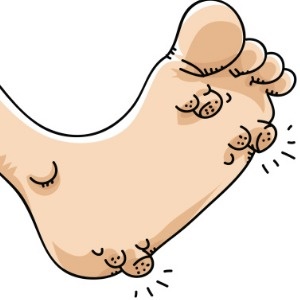
Definition
Plantar warts are hard, tough, horny growths that appear on the plantar surface (sole) of the foot. Normal standing and walking tends to press these lesions into the skin, flattening them and causing pain. Like most warts, they are benign and eventually tend to disappear without treatment, but the pain can become quite severe. They can be distinguished from calluses and corns by their tendency to produce pinpoint bleeding when the surface is pared away. Mosaic warts are plaques of myriad small, clustered plantar warts.
Causes
Plantar warts are caused by the human papilloma viruses (HPV) which infect the skin through small cuts or scrapes. More than 60 types are known; types 1, 2, 4 and 7 are associated with plantar warts. It can take a few months from initial exposure until warts appear. They are contagious and can spread at public swimming pools or showers. One might even get epidemics among people in gyms or other places where people commonly go barefoot. The body develops immunity against these viruses over the years, so that plantar warts are more common in children than adults.
Risk factors
Visiting public swimming pools and showers frequently may increase the risk of contracting the virus that causes plantar warts.
Symptoms and signs
- Plantar warts appear as small, bumpy growths on the soles of the feet, measuring up to 5 cm across, sometimes with small black spots on the surface. They can become pressed into the sole of the foot.
- Pinpoint bleeding may occur when they are traumatised or scratched.
- They can be extremely tender when standing or walking.
Prevention
Since plantar warts may be acquired at public swimming pools or showers, it may be wise to protect the feet by wearing shower shoes, thongs or rubber swimming shoes. It may also help to wash the feet thoroughly with soap after being in such an area.
Treatment
Most plantar warts become painful and therefore early treatment, which achieves faster results with fewer recurrences, is preferable.
One should not attempt to remove the wart at home, but should rather seek treatment by a doctor or a podiatrist.
A salicylic acid-soaked tape can be placed over the wart for several days. Subsequently, while the wart is still damp and soft the doctor can remove it.
Plantar warts can also be treated more effectively with cryotherapy, but this may require frequent attempts if the wart is quite large or resistant. The procedure is very painful but achieves good results.
In very large warts surgical removal under local or general anaesthetic may be indicated, but only as a last resort.
Course
Most plantar warts eventually disappear spontaneously. However, because this may take a long time and they are painful, most people prefer active treatment.
When to see your doctor
You should see a doctor for any lesion on the foot that becomes painful. Most growths are harmless, but some may be more serious. If the area around the wart becomes red, hot, tender or painful after treatment, there may be a secondary infection.
(Reviewed by Prof H.F. Jordaan)




 Publications
Publications
 Partners
Partners















